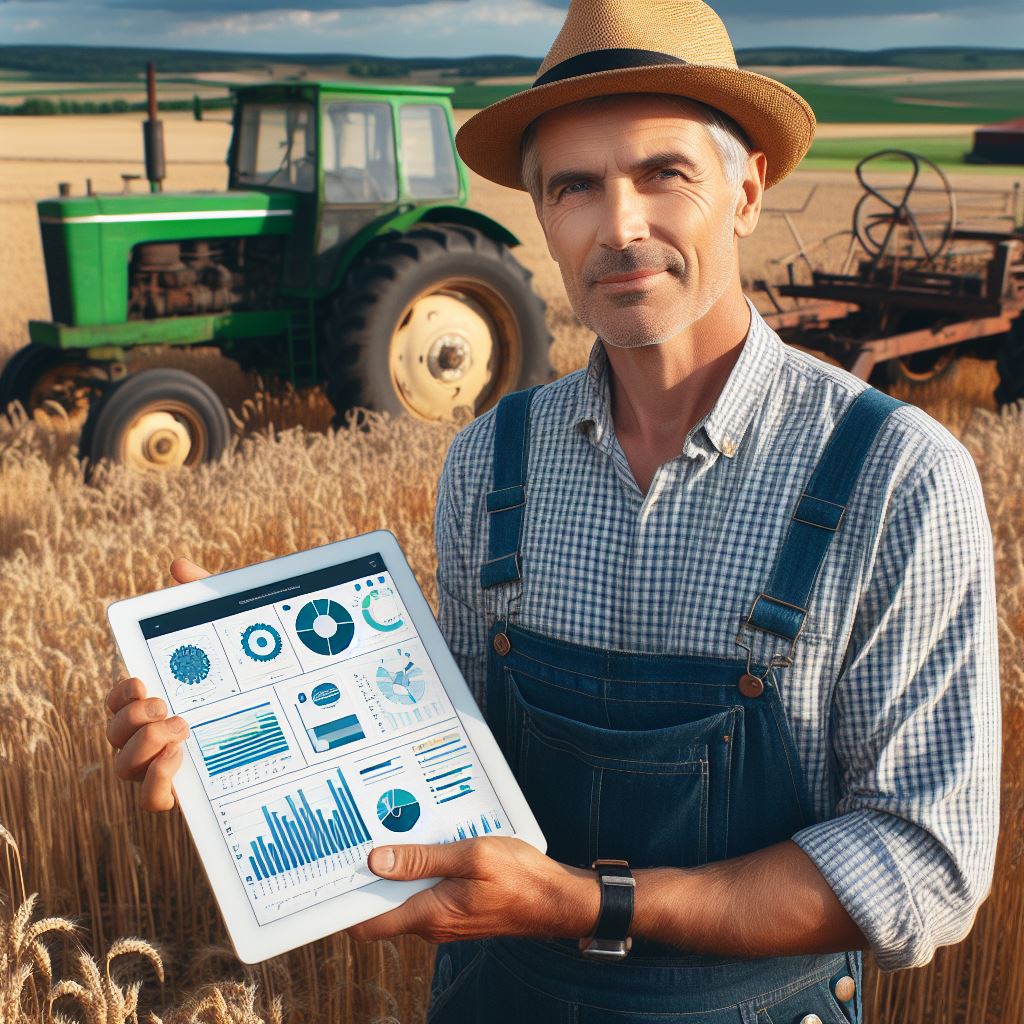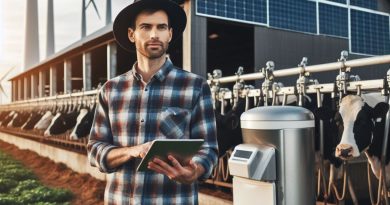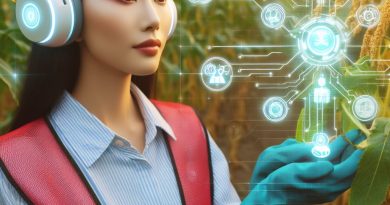Farming Data: AI’s Analytical Power
Last Updated on March 2, 2024
Introduction
The application of AI and data analytics in the farming industry is transforming the way farmers operate.
With the ability to process vast amounts of data, AI technologies offer advanced analytical power that can significantly benefit agricultural practices.
Data is essential in the farming industry as it provides valuable insights that drive informed decision-making.
By leveraging AI’s analytical capabilities, farmers can analyze complex variables such as weather patterns, soil conditions, crop growth, and pest control.
This enables them to optimize cultivation techniques, increase yields, and reduce costs.
Moreover, AI-powered tools and machine learning algorithms can provide real-time monitoring of crops, livestock, and machinery.
Farmers can detect anomalies, manage diseases, and automate routine tasks, leading to more efficient operations.
The potential of AI and data analytics in farming goes beyond the individual farm level.
Aggregated data from multiple farms can be used to identify trends, patterns, and best practices.
This can facilitate collaboration and knowledge sharing among farmers, improving overall industry performance.
In short, AI’s analytical power and the importance of data in the farming industry cannot be overemphasized.
By harnessing the full potential of AI and data analytics, farmers can optimize their productivity, reduce environmental impact, and ensure food security for a growing global population.
What is AI in the Context of Farming?
In order to understand the role of AI in farming, it’s essential to first grasp the general definition of AI and its application in agriculture.
Additionally, exploring specific examples of AI technologies used in farming can provide a clearer picture of its analytical power.
A. Definition of AI in general
Artificial Intelligence (AI) refers to the ability of computer systems to perform tasks that would normally require human intelligence.
It involves the development of intelligent machines that can perceive, learn, reason, and solve problems similar to how humans do.
B. Application of AI in agriculture
AI has found significant application in the field of agriculture, where it helps improve productivity, efficiency, and sustainability.
By leveraging AI technologies, farmers and agriculture professionals can make data-driven decisions and address various challenges in farming.
C. Examples of AI technologies used in farming
AI technologies in farming actively enhance productivity, sustainability, and profitability by optimizing various agricultural processes.
- Precision Farming: Sensors and imaging systems monitor crop health, soil conditions, and weather patterns for efficient management.
- Automated Machinery: Robotics develop autonomous equipment for precise tasks like planting and harvesting.
- Predictive Analytics: Algorithms analyze data to forecast crop diseases, pests, or yield levels.
- Image Recognition: Systems identify weeds, diseases, and nutrient deficiencies for early intervention.
- Smart Irrigation: Algorithms optimize watering schedules based on soil moisture and crop information.
- Animal Monitoring: Cameras and sensors track livestock behavior, feeding patterns, and health indicators.
- Market Analysis: Algorithms provide insights on crop selection, pricing, and marketing strategies.
In summary, AI optimizes farming through sensors, robotics, analytics, and market insights.
Read: Automated Irrigation: Saving Water & Time
The Role of Data in AI-Driven Farming
Agriculture has come a long way in embracing technology, and one of the most revolutionary advancements in recent years is the integration of artificial intelligence (AI) in farming practices.
At the core of AI-driven farming lies the power of data.
Here, we will explore the importance of data collection and analysis, provide an overview of different types of farming data, and discuss the challenges in handling large volumes of farming data.
A. Importance of data collection and analysis
Data collection and analysis are vital in AI-driven farming as they enable informed decision-making and optimization of agricultural processes.
Here are key reasons why data plays a crucial role:
- Improved crop management: By collecting data on soil health, weather patterns, and crop growth, farmers can make data-driven decisions to enhance crop productivity and minimize resource wastage.
- Precision agriculture: Data-driven insights allow farmers to precisely apply fertilizers, pesticides, and water, preventing overuse and reducing environmental impact.
- Early disease detection: Monitoring data from sensors can help identify signs of crop diseases at an early stage, enabling prompt actions to prevent widespread outbreaks and minimize crop losses.
- Market forecasting: Analyzing market data alongside farming data assists farmers in predicting demand patterns, identifying potential market opportunities, and optimizing the timing of harvest and sales.
B. Overview of different types of farming data
In AI-driven farming, numerous types of data are collected and analyzed to gain valuable insights.
The following are the primary categories of farming data:
- Sensor data: Sensors installed in fields provide real-time information on soil moisture, temperature, humidity, and other environmental factors.
- Satellite imagery: Satellite-based systems capture high-resolution images that help monitor crop health, water distribution, and identify areas prone to pest infestations.
- Machinery data: Data from farm machinery, such as tractors and harvesters, enable monitoring of fuel consumption, equipment performance, and maintenance needs.
- Weather data: Weather information, including rainfall patterns, wind speed, and solar radiation, aids in optimizing irrigation, pest control, and crop scheduling.
- Historical data: Historical data on crop yields, market prices, and farming practices provides a valuable foundation for predictive modeling and data-driven decision-making.
C. Challenges in handling large volumes of farming data
The abundance of farming data presents several challenges that need to be addressed for effective utilization of AI in agriculture:
- Data storage and processing: The sheer volume of data generated by sensors, satellites, and machinery requires robust storage infrastructure and efficient processing capabilities.
- Data quality and standardization: Ensuring data accuracy, consistency, and compatibility across different sources and formats is crucial for reliable analysis and meaningful insights.
- Data privacy and security: Safeguarding farming data from unauthorized access, data breaches, and cyber threats is paramount to protect the privacy and business interests of farmers.
- Integration and interoperability: Integrating diverse types of farming data from various sources into a unified system is essential to enable comprehensive analysis and decision-making.
- Skills and training: Developing the necessary skills and providing training to farmers and agricultural professionals to understand and leverage AI-enabled farming technologies is essential.
In review, data collection and analysis are integral to AI-driven farming, offering a range of benefits.
By embracing data-driven decision-making, farmers can optimize crop management, mitigate risks, and increase overall agricultural productivity.
However, addressing the challenges associated with handling vast amounts of farming data is crucial to fully harness the potential of AI in revolutionizing agriculture.
Read: Automated Tractors: The Future is Here
How AI Empowers Data Analysis in Farming
A. Machine learning algorithms and predictive analytics
- Machine learning algorithms are revolutionizing data analysis in farming by identifying patterns and making predictions.
- These algorithms analyze large datasets to uncover valuable insights and trends.
- Predictive analytics in agriculture allows farmers to anticipate crop yield, weather conditions, and disease outbreaks.
- By leveraging AI, farmers can make data-driven decisions and optimize their farming practices.
B. Automation of data processing and decision-making
- AI automates data processing tasks, reducing manual labor and improving efficiency.
- It can collect and analyze data from various sources, such as sensors, drones, and satellites.
- With AI, farmers can detect anomalies in crop health, soil moisture levels, and pest infestations.
- Automated decision-making systems provide real-time recommendations for optimal fertilization, irrigation, and pest control.
- This automation saves time and resources, enabling farmers to focus on other critical aspects of their farming operations.
C. Enhancing productivity and efficiency through AI
- AI-powered tools and technologies enhance productivity by optimizing resource allocation.
- Smart irrigation systems use AI to monitor soil moisture and adjust irrigation schedules accordingly.
- AI-powered robots and drones can perform tasks like planting, harvesting, and monitoring crop health.
- Augmented reality (AR) and virtual reality (VR) technologies help train farmers and improve their decision-making skills.
- By combining data analysis with AI, farmers can minimize waste, increase yield, and reduce environmental impact.
- AI also enables precision farming techniques, where farmers can tailor treatments and interventions to specific areas of their fields.
In a nutshell, AI empowers data analysis in farming by utilizing machine learning algorithms and predictive analytics to uncover insights and make accurate predictions.
It automates data processing tasks, allowing farmers to save time and improve decision-making.
AI also enhances productivity and efficiency through technologies like smart irrigation systems, robots, drones, and AR/VR.
By embracing AI, farmers can optimize their farming practices, increase yield, and reduce resource waste, ultimately leading to a more sustainable future for agriculture.
Read: Agri-Tech Startups: Bridging Tech and Farming
Benefits of AI-driven Analytical Power in Farming
AI-driven analytical power in farming revolutionizes traditional agricultural practices, offering numerous benefits to farmers and the industry as a whole.
By harnessing the power of AI algorithms and real-time data analysis, farmers can achieve improved crop yield and quality
A. Improved Crop Yield and Quality
- AI-powered analytics help farmers monitor and optimize crucial factors that influence crop yield.
- Real-time data analysis allows for timely interventions and adjustments to improve crop growth.
- Predictive models enable farmers to make informed decisions and achieve higher crop quality.
- AI algorithms analyze soil conditions, weather patterns, and plant health to ensure optimal growth conditions.
B. Efficient Resource Management
- AI provides insights on crop water requirements, allowing farmers to implement precise irrigation strategies.
- Sensor-based systems combined with AI analytics minimize water wastage and optimize water usage.
- Precise fertilizer application based on AI analysis reduces costs and minimizes environmental impact.
- AI-driven analytics help farmers manage energy consumption, reducing overall resource usage.
C. Early Detection and Prevention of Crop Diseases
- AI algorithms can analyze plant images and identify early signs of diseases or pest infestations.
- Early detection enables prompt treatment, minimizing the spread of diseases and reducing crop losses.
- AI-powered systems can continuously monitor crops, detecting subtle changes indicative of diseases.
- By analyzing large datasets, AI can identify patterns and help predict disease outbreaks in specific areas.
D. Precision Agriculture and Optimized Farming Practices
- AI enables the use of drones and satellite imagery to collect accurate data about crop health and growth.
- By combining data from various sources, AI can create detailed and dynamic farm management plans.
- AI-powered robots and automated machinery perform tasks with precision and reduce human errors.
- Analytics-driven insights optimize planting patterns, leading to improved land utilization and higher yields.
In closing, AI-driven analytical power presents significant benefits for farming.
Improved crop yield and quality, efficient resource management, early detection and prevention of crop diseases, and precision agriculture are just some of the advantages that AI brings to the farming industry.
Embracing AI technologies can revolutionize traditional farming practices, making them more sustainable, productive, and optimized for the future.
Read: Agri-Drones: Livestock Monitoring Tech

Case Studies and Real-World Examples
A. Success stories of AI implementation in farming
- AI-optimized harvest: Using computer vision and machine learning, AI can identify ripe crops for precision harvesting.
- Crop disease detection: AI algorithms analyze images of crops to identify diseases and recommend suitable treatments.
- Livestock monitoring: AI-powered sensors track animal behavior and health data to ensure their well-being.
- Autonomous farming equipment: Smart machines equipped with AI can perform various tasks like planting, irrigating, and harvesting.
- Weather prediction: AI models can analyze large amounts of weather data to provide accurate forecasts for better farm management.
B. Positive outcomes and impact on farmers’ lives
- Increased yields and efficiency: AI-driven precision agriculture techniques optimize resource allocation, leading to higher crop yields.
- Cost reduction: Efficient resource utilization helps farmers save money on inputs like water, fertilizer, and pesticides.
- Reduced labor demands: Autonomous machinery and AI systems lessen the need for manual labor, reducing farmers’ workloads.
- Enhanced decision-making: AI analytics provide farmers with data-driven insights, enabling them to make better and timely decisions.
- Improved sustainability: AI-driven methods promote environmentally friendly practices, conserving resources and reducing environmental impact.
C. Illustration of how AI-driven analytics have revolutionized the farming industry
- Crop monitoring and management: AI algorithms analyze data from satellite imagery, drones, and sensors to identify crop health issues and suggest appropriate actions.
- Predictive modeling: AI models can predict pest outbreaks, weather patterns, and market demand to help farmers plan ahead.
- Soil analysis and nutrient management: AI-based soil sensors analyze soil composition, fertility, and nutrient levels to optimize fertilization and prevent soil degradation.
- Supply chain optimization: AI analytics enable better inventory management, logistics planning, and forecasting for improved supply chain efficiency.
- Disease prevention: AI-powered systems monitor plant and animal health data, enabling early detection of diseases and timely intervention measures.
Basically, AI-driven analytics have transformed farming by enhancing productivity, reducing costs, and improving sustainability.
Real-world examples demonstrate the successful implementation of AI in various farming domains, such as precision agriculture, livestock monitoring, and weather prediction.
Farmers’ lives have been positively impacted through increased yields, reduced labor demands, and better decision-making capabilities.
The farming industry has experienced a revolution with AI-driven analytics, enabling efficient crop monitoring, predictive modeling, soil analysis, supply chain optimization, and disease prevention.
Potential Challenges and Limitations of AI in Farming
A. Dependence on data reliability and quality
One of the main challenges in using AI for farming is the dependence on reliable and high-quality data.
Agricultural AI systems rely on accurate data to make informed decisions and predictions, but if the input data is flawed, the results will be inaccurate.
It is essential to ensure that the data collected is reliable, up-to-date, and representative of the farming environment.
Issues such as data gaps, incomplete data sets, or biased data can significantly impact the performance of AI algorithms and lead to ineffective recommendations.
Farmers need to invest in data management systems and quality control processes to mitigate these challenges.
B. Cost and accessibility issues for small-scale farmers
Another important challenge is the cost and accessibility of AI technologies for small-scale farmers.
Implementing AI in farming often requires significant investment in infrastructure, hardware, software, and training.
This financial burden may not be feasible or accessible for small-scale farmers with limited resources.
The maintenance and technical support for AI systems can also be costly, which further adds to the financial challenges.
Without affordable and accessible AI solutions, small-scale farmers may be left behind in the digital transformation of agriculture.
Addressing these cost and accessibility issues is crucial to ensure that AI benefits all farmers, regardless of their scale of operation.
C. Ethical implications and concerns regarding privacy and data ownership
- The use of AI in farming raises ethical concerns, particularly regarding privacy and data ownership.
- AI systems gather large amounts of data from farms, including sensitive information about crops, soil conditions, and farm management practices.
- There is a risk of this data being misused, shared without consent, or falling into the wrong hands.
- Farmers are concerned about the ownership and control of their data and the potential for third parties to exploit it for commercial gain.
- Moreover, the use of AI in farming may also lead to the displacement of farm labor, raising questions about job security and social implications.
- Regulations and policies need to be in place to protect farmers’ rights, ensure responsible data usage, and address these ethical implications.
Overall, while AI holds great promise for transforming the agricultural industry, there are several challenges and limitations that need to be addressed.
The dependence on reliable and high-quality data, the cost and accessibility issues for small-scale farmers, and the ethical implications regarding privacy and data ownership are significant concerns.
It is crucial to invest in data management systems, develop affordable and accessible AI solutions, and establish regulations to protect farmers’ rights and ensure responsible AI usage in farming.
By overcoming these challenges, AI can truly revolutionize farming practices, optimize resource allocation, and contribute to sustainable and efficient agriculture.
Delve into the Subject: Future of Farming: Drone Technology
The Future of AI in Farming
A. Predictions and projections for AI advancements
- Increased use of AI technology in farming is expected to revolutionize the industry.
- AI-powered robots and drones will become integral parts of the farming ecosystem.
- Predictive analytics will enable farmers to make data-driven decisions and improve crop yields.
- AI algorithms will continuously learn and adapt to optimize farming processes and resource allocation.
- Farmers will rely on AI for accurate weather forecasting, pest detection, and disease prevention.
- AI will enable real-time monitoring of soil conditions, ensuring optimal nutrient levels for plant growth.
- Efficient water management systems, guided by AI, will conserve water resources and reduce waste.
- AI will revolutionize livestock farming by providing intelligent monitoring and health management solutions.
- The adoption of AI in farming will lead to increased productivity, profitability, and sustainability.
B. Integration of AI with other emerging technologies in agriculture
- AI will be integrated with IoT devices, allowing farmers to collect and analyze real-time data.
- Smart sensors will provide AI with information about temperature, soil moisture, and crop health.
- Blockchain technology will enable secure and transparent data sharing across the agricultural supply chain.
- AI and robotics will work together to automate repetitive tasks and optimize production processes.
- Nanotechnology will enhance the effectiveness of AI-powered solutions in pest control and crop protection.
- AI-powered drones will perform targeted spraying and monitoring, reducing the need for pesticides.
- Virtual reality and augmented reality technologies will enable farmers to visualize and plan their operations.
- AI will collaborate with autonomous vehicles to optimize logistics and transportation in farming.
- The integration of AI with emerging technologies will create an interconnected and intelligent farming ecosystem.
C. Potential implications for the future of farming industry
- AI will lead to a shift in job roles, with farmers becoming data analysts and AI system operators.
- Smaller farms will be able to compete with large-scale operations by leveraging AI technologies.
- Farmers will have access to real-time market insights and demand forecasts, improving business decisions.
- The sustainability of agriculture will be enhanced through AI-driven precision farming practices.
- AI will promote more efficient use of resources, reducing environmental impact and ensuring food security.
- The farming industry will become more resilient to climate change and volatile market conditions.
- AI will enable personalized farming solutions tailored to specific crops, regions, and farmer preferences.
- Global food production will be supported by AI, addressing the challenge of feeding a growing population.
- Collaborative platforms powered by AI will facilitate knowledge sharing and cooperative farming practices.
Ultimately, the future of AI in farming holds immense potential for advancements in agriculture.
Predictions suggest that AI will revolutionize the industry by optimizing processes, improving crop yields, and reducing resource waste.
The integration of AI with emerging technologies like IoT, blockchain, and robotics will further enhance the capabilities of farming systems.
These advancements will have various implications for the farming industry, including job role shifts, improved sustainability, and increased competitiveness.
With the continued development and adoption of AI in farming, the industry is poised for a transformation that will drive productivity, profitability, and global food security.
Conclusion
Throughout this blog post, we have explored the immense significance of AI’s analytical power in the field of farming.
AI technologies have revolutionized the way farmers analyze and utilize data to optimize their operations.
It is crucial for farmers to embrace AI technologies, as they have the potential to greatly enhance farm management practices.
By harnessing the power of AI, farmers can make more informed decisions and improve overall productivity.
We urge farmers to actively explore AI solutions and embrace data-driven practices in their farming operations.
By doing so, they can unlock the full potential of AI’s analytical power and drive sustainable growth in the agricultural sector.


